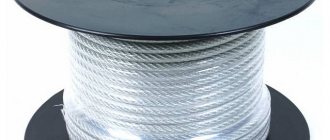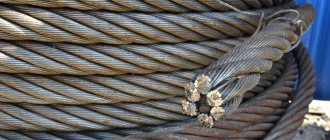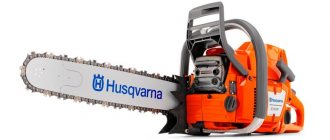Steel ropes are used in lifting mechanisms and rigging work. But it is impossible to thread a rigid cable into the loop of a hoist hook or an embedded part and tie it in a knot like a thin rope. In such connections, a loop is always formed, and the free end of the bent cable is fixed by crimping with a sleeve, clamps, or by weaving into the section of rope following the loop.
It is in such connections that an additional element, a thimble, is used when forming a loop. This is also a steel part with a groove on the outside into which the bent cable fits. Its form can be viewed here www.ropesystems.ru. What is the additional part needed for?
Throttle for steel ropes and cables - a reliable fire
Externally, a rope thimble is a triangular, teardrop-shaped or round frame, which is made by forging or casting from high-strength carbon steel. The products are inserted inside the loop - the fire, and do not slip out thanks to the groove running along the outside. The dimensions of such a product as a thimble can be impressive - some forged marine examples weigh almost 37 kg on their own and are capable of withstanding enormous loads. Of course, smaller specimens are used in construction and everyday life - it all depends on the diameter of the rope or cable that needs to be secured at the bend of the loop.
So, with a rope diameter within 2.5 mm, you will need a thimble with a diameter of 10 mm and a groove radius of 1.5 mm. The diameter of the thimble in this case refers to the distance between the two outermost points of the circle inside the product. If the thickness of the rope is 10-12 mm, you will already need an option with a diameter of 40 mm and a groove radius of about 7 mm. That is, whatever cable or rope you choose, according to the requirements, the diameter of the inner circle of the thimble must be 4 times larger, and the groove must be of such a size that the product “sinks” almost 2/3 into it. Thanks to this, you will ensure maximum safety during work and extend the life of the cable.
There are marine, round, cable-stayed, steel and acid-resistant thimbles, as well as wedge sockets.
- Marine cable thimbles are usually made by hot forging and have a teardrop shape. There are two types of marine products - type C is used for fastening steel ropes, while type P is intended for plant ropes. Both types can be made from either carbon or low-magnetic steels. The largest representative of type C is designed for a cable with a thickness of 66.5 mm in diameter. The numbers in the marking after the letter indicate what load the fastener can withstand, for example, C400 can withstand a load of 40 tf, and P20 can withstand a load of 2 tf.
- Cable-stayed options also came to us from the marine theme, but now they are more often used in the construction industry in various kinds of braces, supports, telescoping and for connecting parts of mechanisms and metal structures. A distinctive feature of cable-stayed products is their smaller internal diameter.
- Acid-resistant elements are made of corrosion- and acid-resistant steel M1-M12. This provides additional reliability of fastenings in production. Such products are easily recognized by their shiny surface.
- Semi thimbles - used to prevent wear and tear of large diameter ropes at small bending radii, which is typical when lifting or towing loads.
- A round galvanized thimble is a solid round product, thanks to which an even circle is formed inside a loop of a cable or rope.
- Wedge options are clips for securing steel ropes in lifting mechanisms. The device consists of a clip, an insert and a wedge, which jams the rope between the walls of the clip, the insert and the wedge itself.
- The thimble for synthetic rope is characterized by the fact that its groove on the sides is closed, which prevents the soft synthetic material from slipping out.
Using a thimble to improve the reliability of cables
The looped ends of the cables and ropes (ogons) are put on the thimble and securely held on it due to the shape of its section, which has the configuration of a gutter. Depending on the scope of application, the size of the fire and the loads experienced, the thimble for ropes or cables can have different sizes. Some models of thimbles for ship ropes, for example, can weigh up to 40 kg, and devices used in the construction industry and everyday life are small in size and weight. The main technology used in the production of thimbles is forging.
The choice of thimble size is mainly influenced by the diameter of the cable for which it will be used. The dimensions of such a device include its diameter, equal to the maximum diameter of the circle that can be inscribed in its inner part, as well as the radius of the groove of its groove, measured in the cross section of the thimble.
There are generally accepted recommendations, according to which the diameter of the thimble should be 4 times the diameter of the cable itself, and the radius of the groove of the groove should be chosen so that the cable in such a groove is buried by 2/3 of its diameter.
Where to buy steel thimbles?
Despite the emergence of high-strength polymers, steel remains the main material for making thimbles. The excellent performance characteristics of steel thimbles determine the high demand for slings made of wire ropes. TD "Stropkomplekt" sells a wide range of professional equipment for rigging work in St. Petersburg, Leningrad region, with delivery to any region of Russia at a reasonable, affordable cost. You can find out more details and place an order by calling toll-free 8 (800) 550-93-95 or by mail
Methods for fixing the cable to the thimble
Rope or cable thimbles will be useless if the fire itself is not reliable enough. Loops can be formed at the ends of cables in various ways. If the loads on the cable are insignificant, then a loop can be formed using a regular clamp or a metal tube, which is flattened after it is used to form a loop at the end of the cable. You can see the details of such a simple technological operation in the photos, which are not difficult to find on the Internet.
In order to make a more secure loop at the end of the cable, you will need to unravel it into two parts, approximately equal to each other in thickness and number of fibers. It is necessary to unravel the end of the cable to a length of approximately 30 cm. This procedure should be performed with gloves so as not to injure your hands with steel fibers. The two unraveled halves of the cable are placed crosswise in the thimble groove and connected to the unraveled part of the cable. The most important thing is to ensure such a connection is highly reliable. To do this, each half of the loose part is passed between the turns of the unloose part, for which a screwdriver is used, with which the turns are moved apart, and the loose part is passed into the resulting gap. For greater reliability, the resulting braided connection can be further strengthened with clamps, a flattened tube or wire twists.
One of the ways to fix a cable with a thimble
Types of thimbles
Structurally, thimbles are divided into several options, which we will consider below.
The round thimble is a steel product processed by galvanizing. It is made in the shape of a ring, so the cable loop forms an even circle.
The ship's thimble is made in the form of a drop using hot forging. There are two main options:
- for use with steel ropes (C);
- for use with plant ropes (P).
The marking provides an indicator of the maximum permissible load.
The cable thimble has a small diameter and is widely used in the construction industry. It is used to fix various structures and mechanisms.
The acid-resistant thimble is notable for its shiny surface. It is used in various industries where there is an aggressive environment. For production, M1-M12 steel is used, which is resistant to corrosion and other influences.
The semi-thong is suitable for large cables with a large diameter. Wedge sockets provide reliable fixation by jamming the clip in the mechanism. There are also options for cables made from synthetic materials.
How to make a thimble with your own hands.
Sometimes in everyday life there is a need to
make a clamp with your own hands
. Making your own clamp is not at all difficult. For this purpose, a small piece of aluminum pipe of suitable diameter into which the two ends of the cable could be inserted would be quite suitable.
The pipe must be bent in an arc at a distance of at least 120 mm. A cable is inserted into this arc, the ends of which are covered with aluminum brackets and secured with bolts and nuts. If you need to increase the cable, the diameter of the pipe is selected so that both pieces of the cable can be inserted into it.
When using homemade clamps, reliability and wear resistance will, of course, be lower than that of factory products.
Therefore, it is better not to use them under heavy loads, but for domestic needs their use is quite justified. Tweet
Not just a thimble - we select the cable for its intended purpose
Along with the thimble, you also need to select a modern cable for its intended purpose. This product in most cases consists of wire wound around a core. The more fibers there are for the same thickness of cable, the more flexibility it will have. Both organic and metal materials can be used as a core. Organic cores are often soaked in a special impregnation, which is gradually released during the operation of the rope and reduces friction between individual strands and fibers in the rope itself, thereby extending its service life.
According to the type of construction, steel ropes have many differences that are not noticeable to the eye. For example, there are only three types of lay: single, double and triple. In the case of a single lay around a central wire or core, the steel wires are twisted in a spiral in several layers, and if the first layer is curled in one direction, then the subsequent layer is curled in the other. When double laying is done, the wires are first twisted into strands, and these strands are curled into a cable; with triple laying, the process is even more complicated. Single fibers have the highest rigidity, but they wear out faster as a result of increased friction between the fibers.
When choosing, it is very important to take into account the maximum breaking force that a particular rope can withstand. For example, galvanized products with a diameter of 2.2 mm have a tensile strength of up to 300 kg, while a three-millimeter rope almost doubles this figure. Products with a diameter of 5 mm can withstand tensile forces of up to 1800 kg!
This is interesting: GOST 3262-75 requirements for steel water and gas pipes
Crimp sleeves
Crimping sleeves for steel cable assemblies are one of the frequently performed functions of equipment for lighter operating conditions.
The question often arises , which is better, crimp ends or wire rope clamps?
Steel Cable Clamps and Crimping Sleeves
Crimp sleeves, stronger and more efficient. Requires no future maintenance or re-tightening of nuts. It has a streamlined shape than metal rope clamps.
Crimping refers to the process of using a tool or machine to apply force to a bushing or ferrule. As a result of this process, the sleeve is sealed on and around the cable portion.
Sleeve crimp
Aluminum crimp fittings
Most often, an aluminum cable clamp is used with galvanized steel cable to form cable assemblies.
Aluminum sleeve placed on a galvanized cable
Aluminum is soft. When compressed, using a crimping tool, it will be pressed into the grooves of the rope , locking the aluminum sleeve in place.
Aluminum sleeve in cable
Installation
Passing the steel rope through the sleeve.
Pass the cable through the sleeve
Before crimping, make sure that the “cut end” of the steel rope sticks out to a length of at least 2 cable diameters. This ensures full contact with the cable as the sleeve expands during crimping.
Two cable diameters
Place the sleeve into the jaws of the tool.
Sleeve correctly in the tool
Sleeve incorrectly in tool
Pay attention to the correct orientation of the crimping tool cavity with the aluminum bushing.
The sleeve should always be aligned vertically, not horizontally.
Keeping the case in the correct position, make your first crimp by squeezing the crimping tool handles together until the jaws are completely closed.
Forging
Sleeve crimp
For each sleeve size there is a prescribed number of crimps that must be completed.
Leave a little space between each crimp. Your finished assembly should look like the image shown.
Crimping distance
For 1/16" and 3/32" sleeves, 2 crimps will be required.
For 1/8" and 5/32" sleeves, 3 crimps will be required.
For 3/16" and 1/4" sleeves, 4 crimps will be required.
For 5/16" and 3/8" sleeves, 5 crimps will be required.
Pressure gauge
To ensure that the crimps are done correctly, use a calibrator.
Pressure gauge
Using the appropriate measuring cavity, slide the sensor onto the sleeve.
If the pressure gauge rotates freely around the crimp zone, then everything is done correctly.
The pressure gauge rotates freely around the crimp area
If the sensor does not slip in the crimp area, use a re-crimp tool to ensure that the coupling has been fully compressed.
Steel rope with polymer coating
It is recommended to trim the vinyl far enough to ensure that the sleeve makes direct contact with the cable.
Vinyl coated cable
Using the same crimping method, elbow joints can be made to connect two pieces of cable.
Knee connection
Remember to leave a small area between the sleeves.
Small area between sleeves
Extend the end of the metal cable beyond the outer edge of the coupling at least 2 cable diameters.
Cable end
Zinc Copper Sleeves
Zinc, copper and glass sleeves are recommended for stainless steel wire ropes.
Zinc and copper hoses
Aluminum sleeves are not recommended for use with stainless steel cables due to the possibility of corrosion of aluminum upon contact with stainless steel. Over time, this can lead to weakening of the contact between the coupling and the cable.
What are the benefits of a thimble?
- The drop-shaped thimble allows you to form an end loop with a smooth bend, which protects the rope from kinks and excessive tension.
- Provides convenience for threading other rigging devices (hooks, staples, lanyards, carabiners, connecting links) into the firebox.
- Prevents abrasion of rope fibers (wires) during intensive use.
- Thanks to the metal mandrel, it is possible to significantly increase the service life of the rope product and increase the safety of rigging operations.
Cable thimbles are most widely used in lifting devices used at construction sites, warehouses, logging sites, manufacturing and ports. They are an important element in the termination of cargo slings, towing ropes, guy ropes, rope rigging of ship rigging and lifting and transport machines.
In rope slings, various end gripping and connecting elements are mounted in a loop with an embedded thimble. The metal mandrel protects the cable from wear in the most vulnerable place, taking on abrasive loads. The shape of hinge reinforcers can be round, triangular, diamond-shaped, but the most common option is teardrop-shaped, manufactured in accordance with GOST 2224-93, DIN 6899 and DIN 3090 (reinforced).











